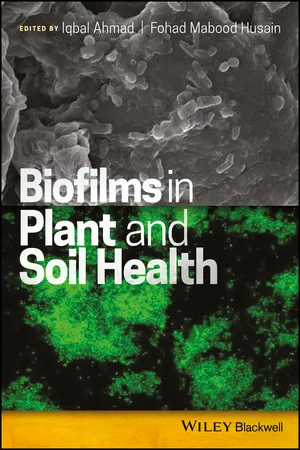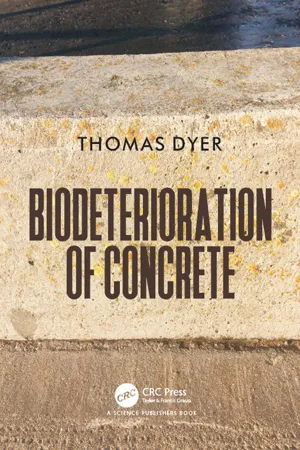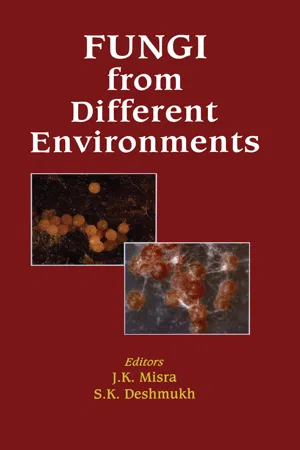Biological Sciences
Filamentous Fungi
Filamentous fungi are a group of fungi characterized by their thread-like structures called hyphae. These fungi play important roles in various ecosystems, including decomposition and nutrient cycling. They are also used in biotechnology for producing enzymes, antibiotics, and food products. Examples of filamentous fungi include molds and mildews.
Written by Perlego with AI-assistance
Related key terms
5 Key excerpts on "Filamentous Fungi"
- Randall T. Hayden, Karen C. Carroll, Yi-Wei Tang, Donna M. Wolk(Authors)
- 2016(Publication Date)
- ASM Press(Publisher)
1 Brian A. Kendall,1, 2Allen T. Griffin,3 and Kimberly E. Hanson1, 214 Filamentous Fungi
INTRODUCTION
Fungi are ubiquitous, eukaryotic organisms found throughout the environment. These microorganisms exist as either saprophytes or parasites, with the former obtaining nutrients from decaying organic matter and the latter sequestering nutrients from a living host. As such, fungi can be both plant and animal pathogens with significant agricultural and medical impact. A limited number of fungi are primary pathogens. These organisms have the ability to cause disease in both immunocompetent and immunosuppressed individuals. In contrast, the majority of Filamentous Fungi causing disease in humans are opportunistic and require specific host conditions be met before infection can occur. Immunocompromised patients are at highest risk for the development of invasive infection with opportunistic organisms. The focus of this chapter is on the medically important filamentous (i.e., molds) and dimorphic fungi known to cause disease in immunocompromised hosts.TERMINOLOGY AND TAXONOMY
Morphology
Fungi can be unicellular or multicellular and, depending on the organism, can take on multiple morphologic forms based on mode of cellular division and growth. In general, fungi grow as either yeast or Filamentous Fungi. Yeast divide by either budding or fission, whereas molds grow by apical extension of their filaments, known as hyphae (singular = hypha). This hyphal growth can occur with or without cell-wall separation of cellular compartments, which is known as septation. Continued growth results in a complex network of hyphae referred to as a mycelium. Whether these hyphae branch while growing or not, and the characteristics of this branching if it does occur, is one of the many characteristics used for the differentiation of groups of fungi. Mode of growth can also be an important factor contributing to the virulence of potentially pathogenic fungi, as both biofilm formation and tissue invasion have been shown to contribute to pathogenesis (1 , 2- eBook - ePub
- Iqbal Ahmad, Fohad Mabood Husain(Authors)
- 2017(Publication Date)
- Wiley-Blackwell(Publisher)
Microbiologists have documented that microbial populations in their natural environments form biofilms—complex communities attached to surfaces in a self-produced polymeric matrix [3–6]. The study of microbial biofilms has led to a shift in our understanding of how microorganisms grow, survive, adapt, and exploit hosts and resources. The bulk of biofilm research has been done on bacteria in aquatic or clinical settings, and a few examples on plants [7–9]. Fungal biofilms have also been studied, mainly in model yeast pathogens responsible for human and animal diseases [10–14]. Only recently have reports of filamentous fungal biofilms been gradually accumulating. The focus of this chapter is to review and integrate what is known about filamentous fungal biofilms with special attention to those formed on or within plant tissues or in soils.8.2 What Is a Biofilm?
The linguistic meaning of the word biofilm literally translates to “biological material in a thin layer, ” but the more we learn about biofilms, the more difficult it is for all to agree on a single definition [15, 16]. A definition for filamentous biofilms becomes additionally challenging because of the unique morphology and tip growth of hyphal filaments when compared to the single-celled populations of bacteria or yeasts undergoing binary fission or budding. Filamentous Fungi cannot always be cultured, measured, manipulated, or enumerated using the same experimental protocols as those used for the individual cells within bacteria and yeast biofilms. As a result, methods for describing and quantifying filamentous fungal biofilms are quite different from those established for bacteria and budding yeasts. Despite these challenges, it is important to define the term biofilm for the purposes of this chapter such that it is inclusive to bacteria, yeast, and filamentous microorganisms growing in natural environments or under laboratory conditions. Herein, we use biofilm - eBook - ePub
- Sarah C. Watkinson, Lynne Boddy, Nicholas Money(Authors)
- 2015(Publication Date)
- Academic Press(Publisher)
Chapter 2Fungal Cell Biology and Development
Nicholas P. Money Miami University, Oxford, OH, USAAbstract
Fungi share most fundamental features of cell structure and function with other eukaryotes. Cell biological distinctions include the unique chemical composition of the fungal cell wall and plasma membrane, and the peculiar mechanisms of hyphal growth in Filamentous Fungi and budding in yeasts. Filamentous Fungi generate multicellular colonies, or mycelia, through the extension and repeated branching of cells called hyphae. Mycelia can be restricted to a patch on a decomposing leaf, or span an enormous territory in a forest ecosystem. Fungi also produce multicellular organs that function in the exploration of the environment and survival under conditions of environmental stress. Fruit bodies, including the familiar mushrooms of basidiomycetes, are multicellular reproductive organs. Mushroom formation involves the coordinated growth of millions of hyphae. The molecular control of hyphal growth and fruit body formation are areas of active research, but many questions about the developmental biology of the fungi are unanswered.Keywords Basidiomata Chitin Dolipore septum Ergosterol Hyphal tip growth Turgor pressure Rhizomorphs Septation Woronin bodies Yeast cell cycleOrganelles, Cells, Organs
Fungi are eukaryotes and much of their cell biology is shared with animals, plants, and protists. Fungal cells are built from the same kinds of organelles as other eukaryotes. They have a plasma membrane, nuclei, and complicated endomembrane system. Most species have mitochondria. A few organelles are not found in other kingdoms. These include a dense assembly of secretory vesicles called the Spitzenkörper that is located in hyphal tips, and the Woronin body of Ascomycota that serves as an intracellular plugging device that stops cytoplasmic leakage. The chitinous cell wall is another distinctive feature of fungal cells. This chapter will provide an overview of the structure of fungal cells, discuss how they grow and multiply to form yeast colonies or branching mycelia, and describe the developmental processes that result in the formation of complex, multicellular organs including cords, sclerotia, and mushrooms (Figure 2.1 - eBook - ePub
- Thomas Dyer(Author)
- 2017(Publication Date)
- CRC Press(Publisher)
Chapter 4 Fungal Biodeterioration 4.1 Introduction Fungi are eukaryotes: their cells contain nuclei and organelles both of which are enclosed by membranes. This configuration of the cell is the same as that for plants and animals.Species of fungi can live in terrestrial or aquatic environments, including seawater. Superficially fungi may seem very like plants—both include unicellular and multicellular organisms, lack motility, and many of the multicellular forms share some common morphological features. However, in taxonomic terms, fungi occupy a separate kingdom to these other organisms. There are a number of reasons for this. Firstly, unlike plants, fungi obtain energy and carbon from organic compounds in the surrounding environment. Secondly, the cell walls of fungi contain the protein chitin, as opposed to plants, whose cell walls are cellulose.Fungi can take the form of both single and multicellular organisms. It is useful to discuss these forms separately, as the differences have some significance to some of the topics covered later in this chapter.4.1.1 YeastsYeasts differ from other forms of fungi both structurally and in their means of reproducing. Yeasts are unicellular, like bacteria, meaning that they are composed of single discrete cells. Unlike bacteria, yeasts are non-motile, and so only move when fluids in which they are present are mobile. Some yeast are capable of attaching to surfaces, which occurs through the formation of adhesive compounds, including sugars, at the cell surface [1 ].Like bacteria, some yeasts reproduce asexually through fission. However, it is more common for asexual reproduction to occur via budding. Budding involves the formation of a small bud on the side of the yeast cell. Once formed, the nucleus of the cell also splits to form two identical nuclei (mitosis - eBook - ePub
- J K Misra(Author)
- 2019(Publication Date)
- CRC Press(Publisher)
4Filamentous Fungi in the Marine Environment: Chemical EcologyMichio Namikoshi and Jin-Zhong Xu1Tohoku Pharmaceutical University, Komatsushima, Aoba-ku, Sendai 981-8558, JapanE-mail: [email protected]1 Present address: Pharmaceutical Informatics Institute, College of Pharmaceutical Sciences, Zhejiang University, Hangzhou, Zhejiang 310058, PR. ChinaAbstract
Marine fungi (including marine-derived strains) are rich sources of biologically active secondary metabolites and interesting research objects for chemical ecological studies. This chapter describes chemical ecology of Filamentous Fungi emphasizing the defensive functions of secondary metabolites. New antimicrobial and cytotoxic metabolites of fungi isolated from marine organisms that may have ecological roles in protection mechanisms of marine organisms and the results on a probable implication of Filamentous Fungi in the indirect chemical protection mechanism of marine sponges are described.A possible role of antimicrobial metabolites produced by fungi isolated from marine organisms is suggested to be a negative cue against fouling, settlement, colonization, adhesion, and infection by potentially harmful microorganisms. Cytotoxic metabolites may be deterrents against larvae and potential predators.Our study demonstrated the possibility that fungi associated with marine sponges may participate in the indirect chemical defense system of the hosts in providing antibacterial metabolites. Bioassay-guided isolation afforded three new and five known antibacterial metabolites against a marine bacterium Ruegeria atlantica, a common fouling species. Penicillic acid, a well known mycotoxin first reported in 1936, may be a ubiquitous antibiotic of marine fungi because this antibiotic strongly inhibited the growth of R. atlantica
Learn about this page
Index pages curate the most relevant extracts from our library of academic textbooks. They’ve been created using an in-house natural language model (NLM), each adding context and meaning to key research topics.




